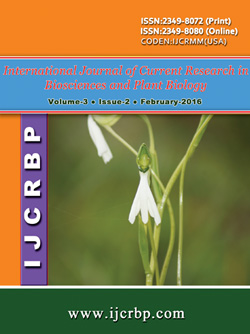 |
Online ISSN : 2349-8080 Issues : 12 per year Publisher : Excellent Publishers Email : editorinchiefijcrbp@gmail.com |
2 Agricultural Botany Department (Agricultural Microbiology), Faculty of Agriculture, Kafrelsheikh University, 33516, Kafr El-Sheikh, Egypt
3 Agricultural Botany Department (Agricultural Botany), Faculty of Agriculture, Kafrelsheikh University, 33516, Kafr El-Sheikh, Egypt
4 Soil Sciences Department, Faculty of Agriculture, Kafrelsheikh University, 33516, Kafr El-Sheikh, Egypt
Biodegradation of the selective herbicide pendimethalin which is used to control most annual grasses was investigated in water and soil. A pendimethalin degrading bacterial isolate (designated strain E20) was isolated using enrichment technique from wheat soil previously treated with the herbicide pendimethalin on the basis of morphological, physiological and genetical (16s rDNA) tests, this bacterial isolate proved to be identified as Pseudomonas resinovorans E20. Results showed that the optimum pH and temperature for the growth of pendimethalin degrading strain were 7 and 30°C, respectively. Additional carbon sources (glucose, lactose, starch, carboxymethyl cellulose and phenol) decreased pendimethalin degradation. Pseudomonas resinovorans E20 was used to remove pendimethalin from aquatic system with half-life of 5.9 days. Pendimethalin half-life was 49.2 days in untreated mineral liquid medium as control. Pseudomonas resinovorans E20 was also evaluated for degradation of pendimethalin in clay soil with half-life of 5.004 days, its half-life was 66.9 days in untreated clay soil. The obtained results illustrated that pendimethalin treatment reduced all measured plant features (plant height, root length, xylem vessels diameter, thickness of phloem tissue, vascular bundle as well as vascular bundle width) in comparison to the other treatments. On the other side, treatment with Pseudomonas resinovorans E20 led to improving and increasing the above investigated parameters. Evaluation of the genotoxic effects of pendimethalin on the genetic material of Vicia faba plants revealed that, the highest abnormal mitosis percentage (63.28%) was recorded for pendimethalin treated plants. On the other hand, Vicia faba plants treated with the bacterial strain Pseudomonas resinovorans E20 decrease the abnormal mitosis percentage which reached to 21.35% in comparison with the control treatment which gave a percentage of 3.85%. This indicates the degenotoxic effect of this bacterial strain pseudomonas resinovorans E20. At the biochemical genetic level, the two treatments (pendimethalin and pseudomonas resinovorans E20) induced some changes in protein banding patterns of Vicia faba plants. These changes included the disappearance of three protein bands with MW′s of 265, 175 and 40 KDa after treatment with the herbicide pendimethalin alone and appearance of the same bands after treatment with Pseudomonas resinovorans E20 bacterial strain.
